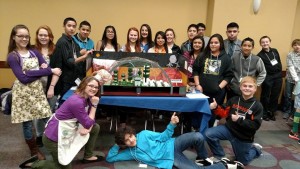Science teacher Sarah Walters took Salmon River middle school students on a field trip to the dump. Then they paid a visit to the Riggins sewage treatment facility. All in the name of getting kids interested in science and engineering.
Saturday, Jan. 23, students from Riggins will join hundreds of other middle school students from 23 Idaho schools, plus teams from Utah and Nevada, as they converge on the Boise State University Student Union for the 12th annual Future City Regional Competition.
The top team will win a trip to Washington, D.C., to compete with other middle-schoolers from around the country in the Future City Competition National Finals, Feb. 13-17.
“They love it,” said Walters. “The kids who participated last year begged me to do it again this year.”

The Future City Competition is a national, project-based learning experience where students imagine, research, design and build cities of the future. Using the engineering design process and project management as a framework, students are asked to address a real-world question.
This year’s theme — Waste Not, Want Not — encourages students to design waste management systems for residential use and small businesses. They learn how today’s engineers and city planners deal with issues such as collection, separation, processing, recycling, health and safety, energy efficiency, environmental impact and cost. Then they design a plausible solution to help tomorrow’s citizens reduce, reuse, recycle and rot to reduce their footprint on the planet.
Lynn Olson, Advisor/Recruitment Coordinator in the Boise State College of Engineering, is the Future City regional coordinator. She sees several reasons why students, teachers, parents and volunteers are enthusiastic about Future City.
“This is a student-driven program where students get to a make the decisions,” Olson said. “I think that ownership of their city with their ideas, many of which are the results of debate and compromises, gives them that ultimate sense of accomplishment.”
Olson said the imaginative, collaborative nature of the program allows students to be creative, an aspect of engineering that sometimes can be lost in science and math. The SimCity™ game, in which students create a futuristic city to launch their project, brings a fun element.
The other components on which they are judged include:
- A project plan to keep them organized and focused throughout their preparations.
- A 1,500-word essay describing the unique attributes of their city.
- A 3D model made of recycled material.
- A seven-minute oral presentation followed by questions from the judges.
Lake Hazel Middle School in Meridian took first place in last year’s regional competition and has two teams competing in Future City this year.
Caitlin Scott, who teaches sixth grade math, is the new team leader for Lake Hazel.
“It helps students not just focus in one area like English, math or science, but it brings it all together,” Scott said. “A lot of students struggle with combining subjects into one.”
She said the biggest challenge students face is learning to concede to one another.
“They all have such big, great ideas, they have a hard time seeing how to merge their ideas,” Scott said.
Melyssa Ferro teaches science at Syringa Middle School in Caldwell and has been participating in Future City for several years. She sees communication and collaboration as key components of the experience.
“There’s always a strong science component, and students get to look at and practice the engineering design process,” Ferro said. “But they also experience real-world collaboration — things that go into every career, regardless of how STEM-oriented it is.”
Future City teams can comprise as few as three or four students. Each of Ferro’s three teams, though, involves an entire class of about 30 kids. They sort themselves into task groups and select their own group leaders.
Working in such large teams involves a higher level of authentic collaboration, Ferro said, and she’s proud of the fact that teams from Syringa consistently bring home the Special Award for Best Project Team.
The Special Awards are made possible through donations from engineering and technical firms and professional societies around the state, Olson explained. Even more important than their financial contributions, she said, are the volunteer hours they commit to Future City.
Each team has a mentor who is a professional in an engineering or technical field or a current college student. Mentors meet with the teams to review their plans, essays and models and help them think about how to solve problems.
Dylan Rinker, a 2008 graduate of Salmon River High, went on to earn his bachelor’s and master’s degrees at the University of Idaho. He is now a design engineer for Bowtech Archery in Eugene, Ore., and is in his second year of mentoring teams at his alma mater.
“I think it’s really beneficial to help students develop a problem-solving mindset to address issues that everyone faces,” Rinker said. “And exposing them to careers in engineering can help lead them down that road.”
The public is invited to the competition Jan. 23 in the BSU Student Union. Olson said things can get “kinda crazy” during judging from 9:30-noon. From 1:30 p.m. to 2:30 p.m., the five finalists present in front of an audience of about 400 people.
